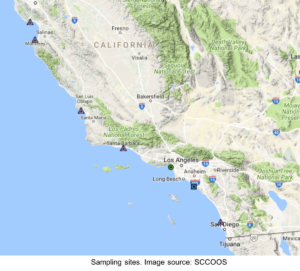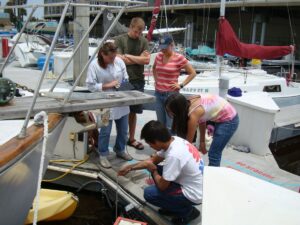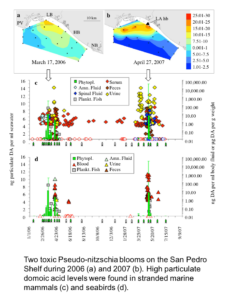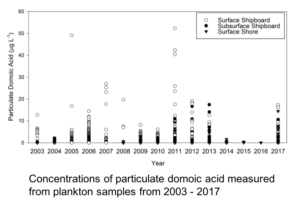 We have been conducting studies of harmful algal blooms (HABs) in San Pedro Bay, CA since 2003. One component of that work has been maintaining a sampling program at Newport Beach (since 2008). Our lab samples the plankton there weekly from Newport Beach Pier, where the Southern California Coastal Ocean Observing System (SCCOOS) maintains an automated sampling site that records temperature, salinity, and chlorophyll. Our weekly monitoring is carried out in collaboration with the other monitoring sites distributed from San Diego to Santa Cruz and maintained by other university HAB research groups.
We have been conducting studies of harmful algal blooms (HABs) in San Pedro Bay, CA since 2003. One component of that work has been maintaining a sampling program at Newport Beach (since 2008). Our lab samples the plankton there weekly from Newport Beach Pier, where the Southern California Coastal Ocean Observing System (SCCOOS) maintains an automated sampling site that records temperature, salinity, and chlorophyll. Our weekly monitoring is carried out in collaboration with the other monitoring sites distributed from San Diego to Santa Cruz and maintained by other university HAB research groups.

A set of ‘core’ measurements are made at each of the HAB monitoring sites by the various HAB research groups. These measurements include:
1. Taxonomy and abundances of HAB species: Samples are examined microscopically to identify and count algal species that are known to produce harmful effects. Several HAB taxa that are common in the region and of particular interest include species of Pseudo-nitzschia (the cause amnesic shellfish poisoning), Alexandrium (the cause of paralytic shellfish poisoning), Lingulodinium Prorocentrum, Cochlodinium, Heterosigma, and Dinophysis (the cause of diarrhetic shellfish poisoning).
2. Domoic acid concentrations (and other algal toxins, if appropriate): Domoic acid is a powerful neurotoxin produced by species of the diatom genus, Pseudo-nitzschia. These species and this toxin have been a focus of our research in the Southern California Bight for many years (also see ‘Completed Research’). Samples collected by the HAB research groups are processed in our lab for particulate and dissolved fractions of the water samples when putative domoic acid producers (Pseudo-nitzschiaspecies) are observed in water samples. These weekly measurements from pier samples have been augmented by several major research efforts in our coastal waters to over the years to yield a 15-year dataset on the occurrence of domoic acid in along the coast of southern California.
3. Other pertinent measurements are also made weekly at the piers to provide contextual information on water quality and help explain the occurrence of harmful algae in our coastal waters. These measurements include various nutrients, chlorophyll concentration (a measure of plant biomass in the water), temperature and salinity.


Domoic acid has been the cause of several ‘mass mortality events’ of marine mammals and seabirds along the southern coast of California during the past two decades. Marine mammals and seabirds affected during these events are exposed to the toxin via trophic movement of the toxin through the marine food web. Planktivorous fish (e.g. anchovies and sardines that filter minute algae out of the water) are an important vector for exposure to fish-eating animals. Major mortality events were recorded in 2007 and 2008, and mostly recently in 2017. Domoic acid is also a cause of health illness. It is the cause of amnesic shellfish poisoning (ASP), and can cause severe neurological complications and death if ingested in sufficient amounts.
 The SCCOOS HAB monitoring project has been funded since 2008 by NOAA through the Southern California Coastal Ocean Observing System (SCCOOS), and the Central and Northern California Ocean Observing System (CeNCOOS).
The SCCOOS HAB monitoring project has been funded since 2008 by NOAA through the Southern California Coastal Ocean Observing System (SCCOOS), and the Central and Northern California Ocean Observing System (CeNCOOS).